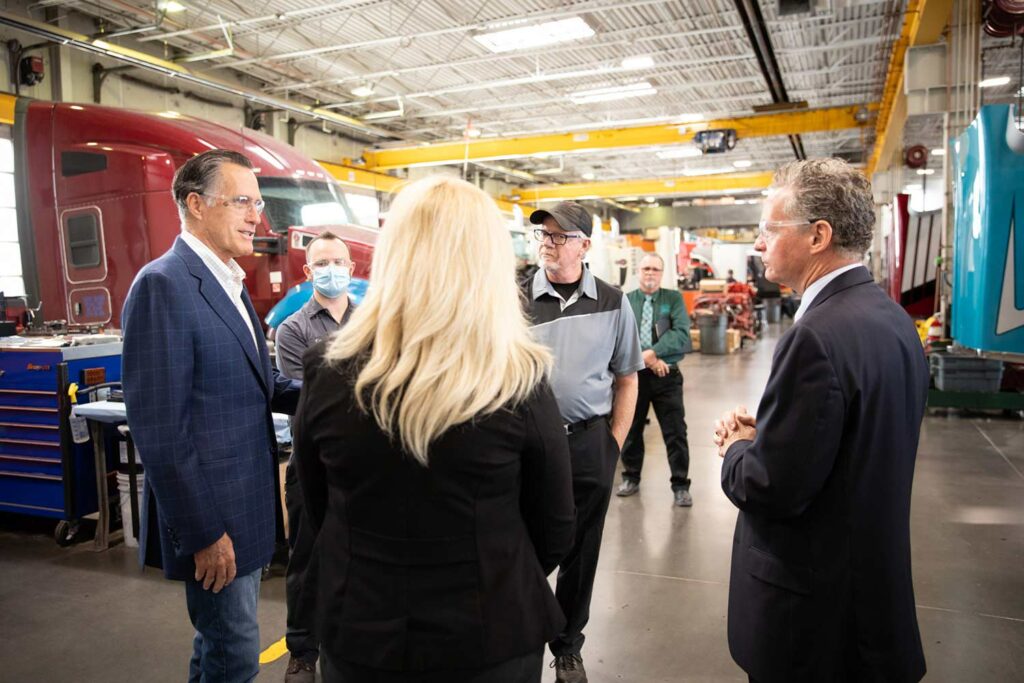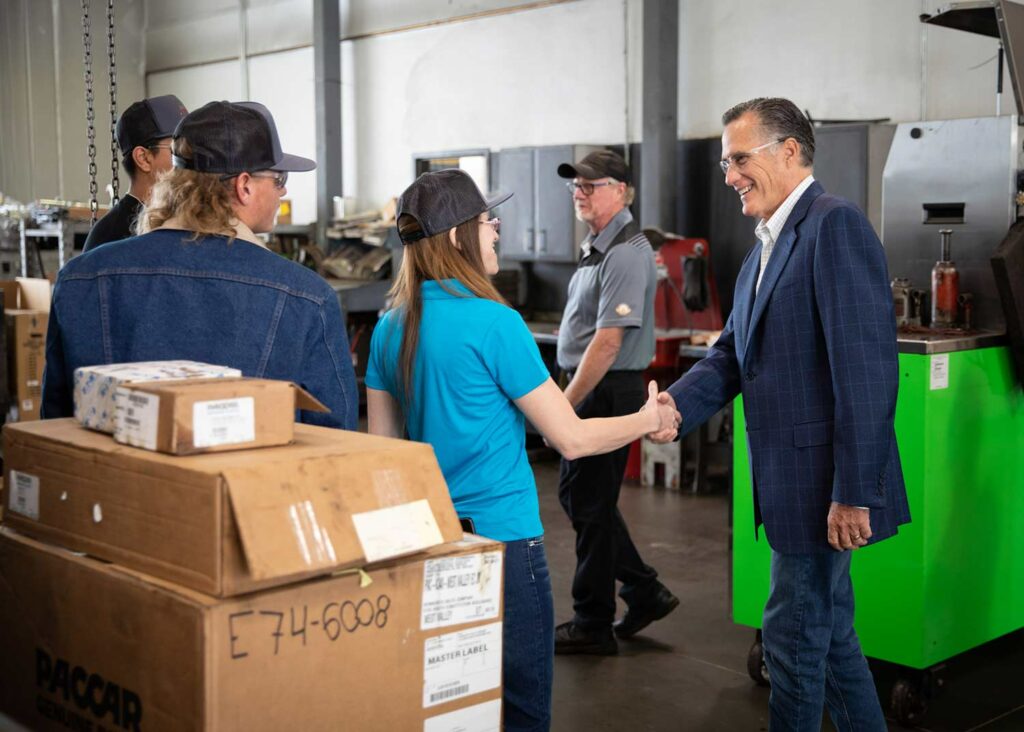What’s the answer to national labor shortage, supply chain issues? Mitt Romney says young people are key
As American companies grapple with historic labor shortages and supply chain issues, some industries are trying to steer young people away from traditional four-year college programs, while trying to make technical careers more appealing.
How to make the trades — specifically those in diesel and transportation — more enticing for high-school and college-aged Utahns was front and center during a roundtable discussion between Utah Sen. Mitt Romney and industry stakeholders at Kenworth Sales in West Valley City on Friday.
A key takeaway, Romney said, was that young people need to “understand the career options that they have beyond the track that you might get at a four-year college.”
“That, I think, is really important, finding a way to communicate that to our high school students so they can recognize that you can make a very good living in a number of trades and have terrific job security, which may not be available in some of the other areas that you have been thinking of going into,” he told the Deseret News.
Before the pandemic, Kyle Treadway, president of Kenworth, said there was a nationwide shortage of about 60,000 diesel technicians. Now, Treadway estimates that number has jumped to about 80,000.
The trucking industry is seeing similar shortages. A recent report from the American Trucking Association estimates the industry is short of 80,000 drivers. By 2030, that number could rise to 160,000.
The trucking industry is also dealing with increasingly high turnover rates. A separate report from the association suggests the turnover rate at “large truckload carriers” surged 16 percentage points to 90% during the second quarter of 2021. It’s the highest turnover rate since 2015.
The shortage has widespread impacts on companies like Kenworth, which is leaning heavily on apprenticeships. Apprentices typically make up about 25% of the company’s workforce, Treadway said. Since the pandemic, in some locations they now make up between 80% to 90%.

In addition to the labor shortages, companies like Kenworth are hurting from the supply chain issues felt in just about every corner of the economy. For the diesel industry, it’s almost everything, from computer chips to chemicals.
Sara Shaw, the service manager for the Salt Lake Kenworth dealership, said of all the trucks in the lot, 58 of them are waiting for parts, some for several months.
“It’s hard to explain to a customer why their truck is going to be down for two or three months waiting on an engine control module. … There might be one or two components a few years ago that we would have a hard time getting our hands on. Now it’s widespread,” she told Romney as the two chatted in front of a semitruck.
“It’s not just the electronics either. It’s really strange. It’s a lot of the manufactured items we’re not able to get,” Dennis Knowley, shop foreman at Kenworth, told Romney. “I can’t even get my hand soap.”
Romney described the supply chain issues and labor shortages as symbiotic, stemming in part from the Biden administration’s $1.9 trillion American Rescue Plan rolled out in January, which he says empowered the consumer but didn’t incentivize people to go back to work.
“The economy was already rebooting. That payment helped to encourage inflation, which we’re seeing across the country. And in some cases it I’m sure made it more difficult for people to decide to go back to work, not always, but in some cases that may have been a factor.
“We need people back in the workforce and a lot of people have dropped out,” he said, before noting, “The consumer is there, but the supply chain shortages that we’re seeing and the inflation that we’re seeing are really problems.”
One of the solutions to the industry’s labor shortage touted Friday was the Utah Diesel Tech Pathways program, part of a broader approach to make the jobs in the diesel and transportation industry more appealing to young people.
Formed in 2017 by the Governor’s Office of Economic Development, the program partners with schools in 16 counties, including Salt Lake Community College, Jordan, Davis, Canyons, Tooele and Alpine school districts. It connects students to industry partners like Kenworth to incentivize students a career in diesel mechanics.

It can be difficult to fight stereotypes sometimes attached to the trades — apprenticeships, job shadowing and other programs that work with high school students try to emphasize that “it’s not the greasy environment that everybody has to work in,” said Treadway.
“We are a clean profession. We are modern, we are sophisticated — trucks are computers on wheels today,” he said.
During the roundtable, industry representatives detailed their programs to incentivize more young people in the workforce. The Utah Transit Authority has apprenticeship programs for kids right out of high school. Salt Lake Community College’s diesel technician program is growing. Jordan School District’s diesel technical pathways program has 52 students enrolled, when several years ago it only had seven. And Savage Services just launched a partnership with Hillcrest High School.
But the stakeholders say that even with the bolstered programs, it’s not enough. That’s why Treadway says his company also sees immigration as part of the solution.
“I’m no expert on immigration, but I have to think that’s a major part of why we don’t have the influx of new talent that we need,” he said. “We’re starting to direct some of our attention and investment towards that community. We’re advertising for Spanish as a first language. We want to hire people in all of our fields, sales, administration, service, etc … because we know that’s what our customer base is doing, and we need to reflect that combination as well.”
Romney echoed Treadway, telling the Deseret News he wants to see the states, not the federal government, dictate the number of visas issued. That way, he said, states will be able to fill the gaps in a labor market that often has varied demand.
“I’d far rather it come from the state,” he said. “If we need additional workers in agriculture or in other parts of the state, let’s let them come in.”

